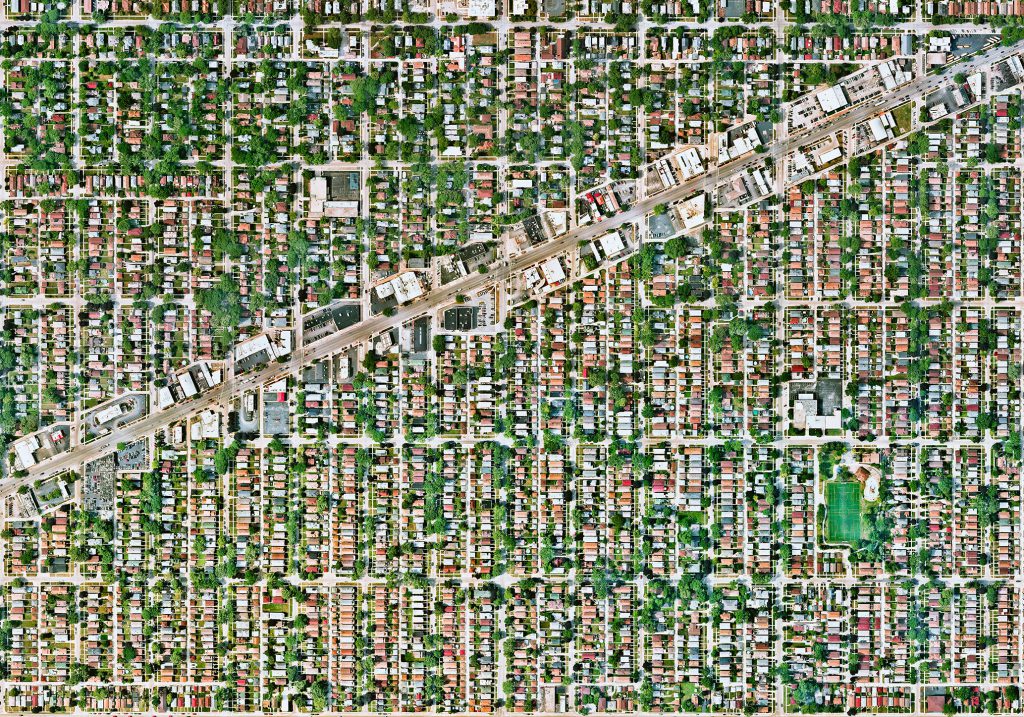
Benjamin Grant: Berwyn, Illinois, 2023.
As the founder of Overview, Benjamin Grant uses satellite and aerial photography to show how human activities and natural forces shape our earth. Berwyn, a suburb in the Chicago metropolitan area, is known as the "City of Homes" and has the highest population density of any municipality in Illinois, with 57,250 residents in just ten square kilometers.
© Photograph: Nearmap, Photo created by Overview
Suburbia traces the history of an ideal life-style that – starting in the US suburbs – conquered the world and is constantly reproduced by popular media. At the same time, the exhibition analyzes the contradictions of this model and its social and ecological consequences such as land consumption, soil sealing, and vacancy. The big question is: What happens next?
The American dream can be described with a timeless image: a large house with a yard, swimming pool, and two cars in the garage. A quiet, safe place for the nuclear family, close to nature and in people-friendly surroundings. Suburbia leads us into this world of ideas and images that has been hugely promoted by politics, business, and the entertainment industry. The cultural history of the single-family home has its origins in the upscale American residential areas of the early nineteenth century. After the Second World War, the typology was massively developed and rolled out on a broad scale. The exhibition sheds light on the economic, political, and social context of this rapid expansion in the USA and beyond. It becomes clear that the model is based on social, ethnic, and gender-specific segregation and devours a tremendous amount of space.
Curated by Philipp Engel for the Centre de Cultura Contemporània de Barcelona (CCCB), the exhibition was adapted by the Az W and expanded to include an Austrian focus. Even in Austria a large share of the population still wants to realize their own version of this dream on the outskirts of the city. According to a recent study by the University of Natural Resources and Life Sciences, Vienna (BOKU), the proportion of highly sprawling areas in Austria increased fivefold between 1975 and 2020 – particularly due to detached single-family homes, large-scale industrial parks, and shopping centers. As a result, traffic areas are destroying the landscape, the rapidly advancing sealing is threatening biodiversity and food security, village centers are becoming desolate, and households are ending up isolated and overwhelmed in an increasingly older society. The image of half-abandoned, aging houses and residential estates characterizes many parts of the country. Instead of building new ones, the question arises as to how the existing stock of these approximately 1.5 million single-family homes can be made usable for the future. Successful examples of conversions, repurposing, densification, or new forms of living and working are intended to demonstrate the enormous potential and attractive alternatives.
With a wealth of historical material, photographs, films, literature, artistic works, and everyday objects, the exhibition tells the story of the commercial success of single-family home and invites reflection on the future perspectives of this form of living.
An exhibition organized by the Architekturzentrum Wien and the Centre de Cultura Contemporània de Barcelona.
Curatorial team: Philipp Engel (CCCB) / Lene Benz, Katharina Ritter, Agnes Wyskitensky (Az W)
Design: Nicole Six & Paul Petritsch
